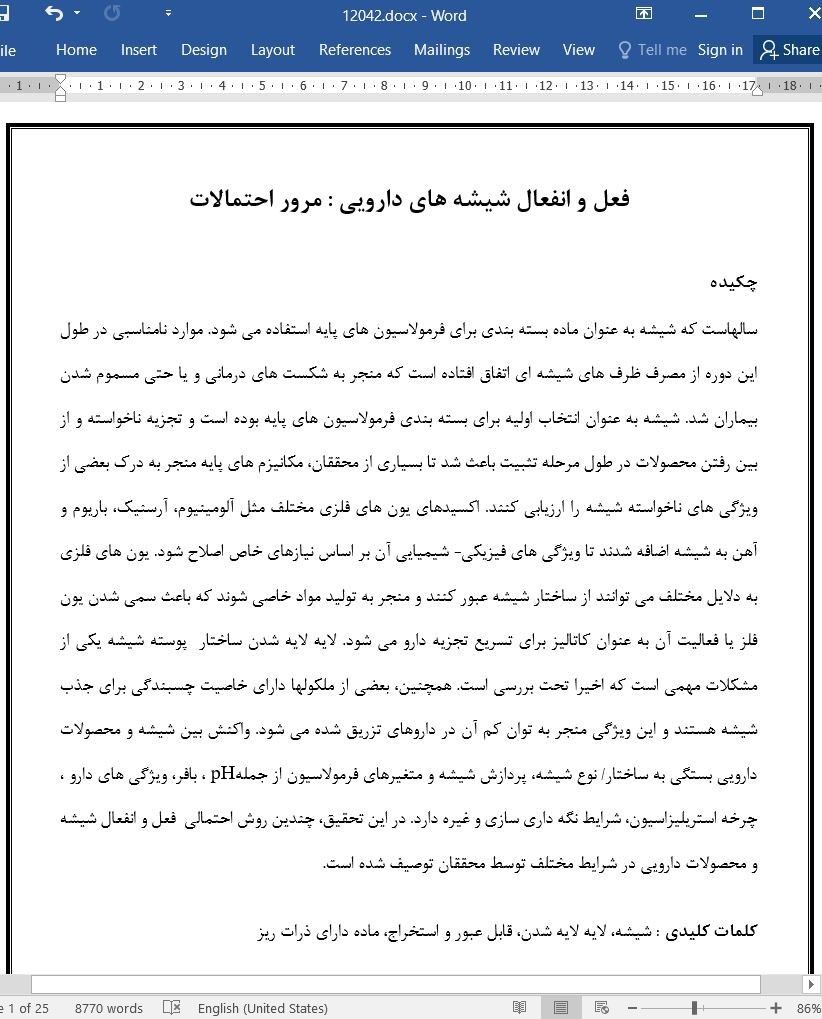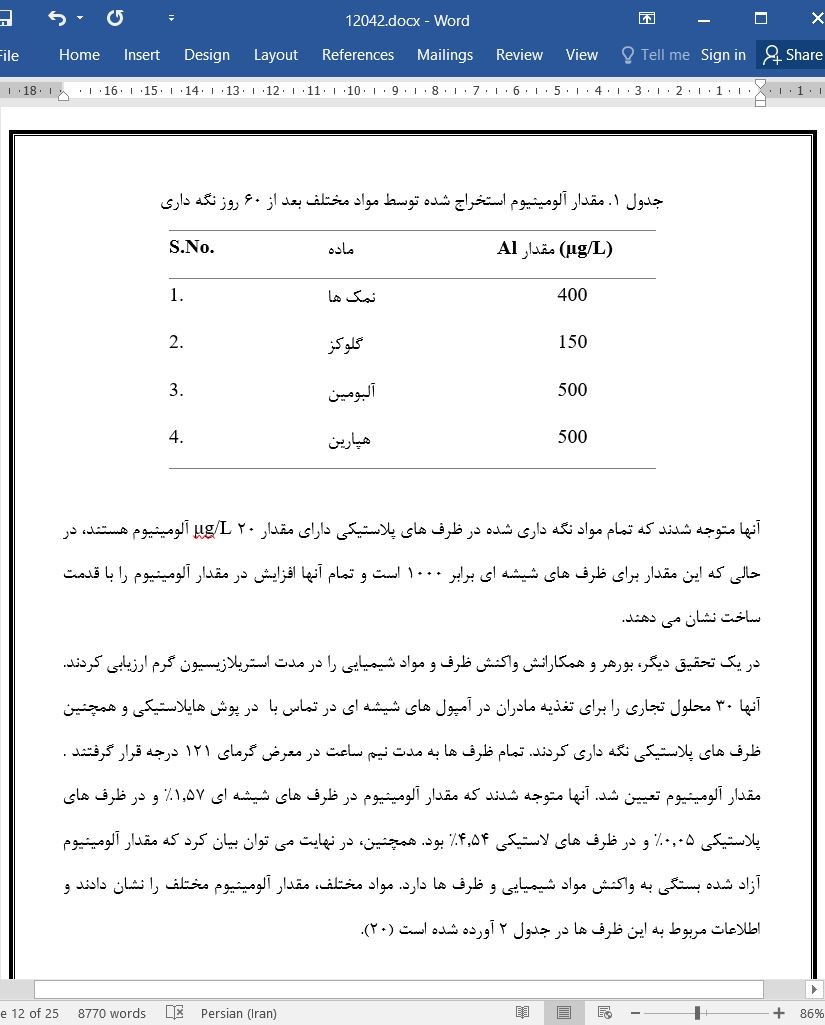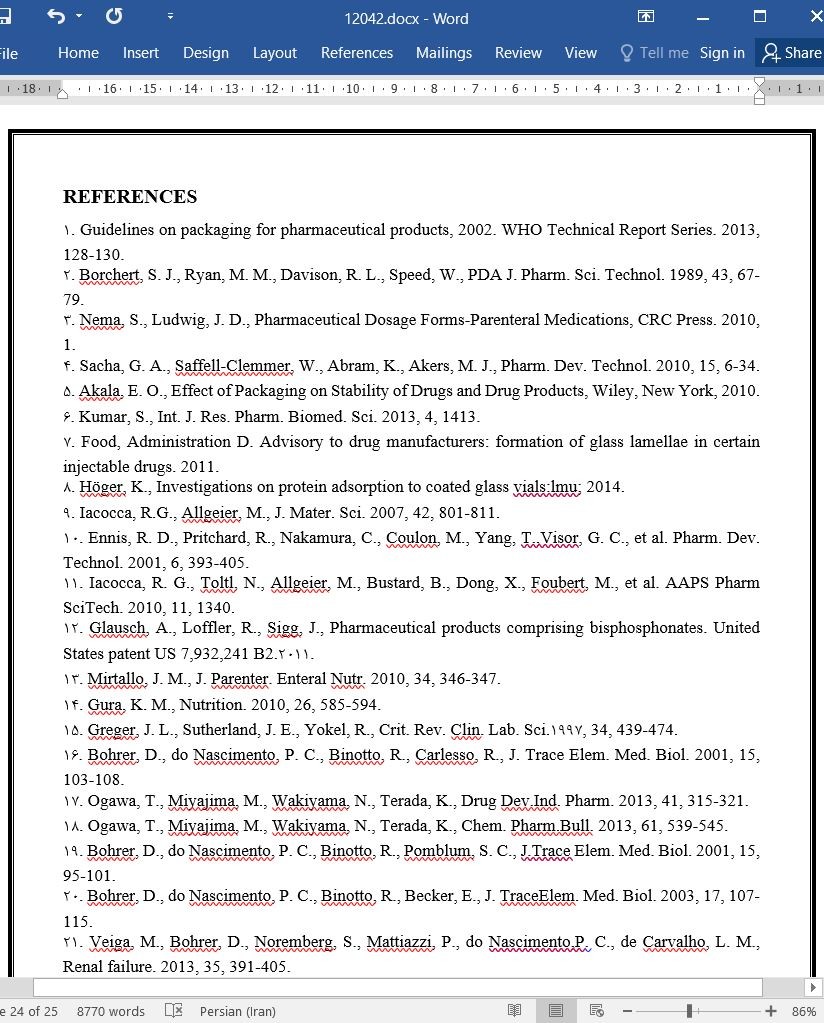
فعل و انفعال شیشه های دارویی: مرور احتمالات
چکیده
سالهاست که شیشه به عنوان ماده بسته بندی برای فرمولاسیون های پایه استفاده می شود. موارد نامناسبی در طول این دوره از مصرف ظرف های شیشه ای اتفاق افتاده است که منجر به شکست های درمانی و یا حتی مسموم شدن بیماران شد. شیشه به عنوان انتخاب اولیه برای بسته بندی فرمولاسیون های پایه بوده است و تجزیه ناخواسته و از بین رفتن محصولات در طول مرحله تثبیت باعث شد تا بسیاری از محققان، مکانیزم های پایه منجر به درک بعضی از ویژگی های ناخواسته شیشه را ارزیابی کنند. اکسیدهای یون های فلزی مختلف مثل آلومینیوم، آرسنیک، باریوم و آهن به شیشه اضافه شدند تا ویژگی های فیزیکی- شیمیایی آن بر اساس نیازهای خاص اصلاح شود. یون های فلزی به دلایل مختلف می توانند از ساختار شیشه عبور کنند و منجر به تولید مواد خاصی شوند که باعث سمی شدن یون فلز یا فعالیت آن به عنوان کاتالیز برای تسریع تجزیه دارو می شود. لایه لایه شدن ساختار پوسته شیشه یکی از مشکلات مهمی است که اخیرا تحت بررسی است. همچنین، بعضی از ملکولها دارای خاصیت چسبندگی برای جذب شیشه هستند و این ویژگی منجر به توان کم آن در داروهای تزریق شده می شود. واکنش بین شیشه و محصولات دارویی بستگی به ساختار/ نوع شیشه، پردازش شیشه و متغیرهای فرمولاسیون از جملهpH ، بافر، ویژگی های دارو ، چرخه استریلیزاسیون، شرایط نگه داری سازی و غیره دارد. در این تحقیق، چندین روش احتمالی فعل و انفعال شیشه و محصولات دارویی در شرایط مختلف توسط محققان توصیف شده است.
مقدمه
مواد بسته بندی متعددی برای مصارف مختلف استفاده می شوند. انتخاب مواد بسته بندی عمدتا بستگی به موارد زیر دارد:
- نوع مقدار مصرف
- شیوه استفاده
- ویژگی های فیزیکی و شیمیایی فورمولاسیون مواد مورد استفاده شده در بسته
- ویژگی های فیزیکی و شیمیایی فورمولاسیون مواد مورد استفاده برای بسته بندی
نیازهای قانونی نیز با توجه به نوع کاربرد محصولات دارویی متفاوت می باشد. برای مثال بسته بندی مواد پایه نیازمند قوانین شدید می باشد زیرا استریل کردن یکی از نگرانی های اصلی برای محصولات می باشد(1). سازمان غذا و دارو نیز کنترل کیفیت ویژه و قوانین بسته بندی را بر اساس میزان مصرف پیشنهاد کرده است. ظرف های شیشه ای از سالیان دور کاربرد گسترده ای برای بسته بندی مواد پایه داشته اند.
نتیجه گیری
شیشه پرکاربردترین ماده برای بشته بندی مواد پایه است. کاربرد شیشه در صنعت داروسازی به سال های خیلی دور باز می گردد. تعداد زیادی تحقیق در این حوزه موجود است که دلالت بر مزایا و معایب شیشه دارد. اطلاعات زیادی وجود دارد که به مکانیزم های احتمالی واکنش شیشه با دارو اشاره می کنند و از این اطلاعات باید برای پیش بینی واکنش های نامطلوب استفاده تا بتوان از میان گزینه های موجود برای بسته بندی انتخاب کرد و یا اینکه تغییراتی در نوع شیشه یا فرمولاسیون ایجاد کرد. اگرچه در مورد واکنش های احتمالی محصول شیشه بحث کرده ایم، اما این ماده به عنوان گزینه برتردر مقایسه یا سایر مواد در نظر گرفته می شود که دلیل آن خنثی بودن و سهولت فرایند برای فرمولاسیون های پایه می باشد. بنابراین، علیرغم پتانسیل شیشه برای واکنش، این ماده یک ماده مناسب برای ساخت ظرف های اولیه فرمولاسیون های پایه می باشد. این مطلب در صورتی صدق می کند که محققان فرمولاسیون را ارزیابی کنند و واکنش های احتمالی در فاز اولیه توسعه فرمولاسیون را حذف کنند.
Abstract
Glass is used as packaging material for parenteral formulation from years. Various untoward occurrences have observed over the period of time with glass containers which leads to therapeutic failures or even toxicity to the patients. Glass has been the primary choice for packaging of parenteral formulations, unexpected degradation or product losses during stability have forced many researchers to evaluate the underlying mechanisms leading to a larger understanding of some of the untoward properties of glass. Oxides of various metal ions viz. aluminium, arsenic, barium, iron etc. are added in glass to modify its physicochemical properties based on specific requirements. Metal ions could leach from the glass structure due to several reasons and could lead to generation of particulate matter, could cause metal ion toxicity or act as catalyst to hasten drug degradation. Delamination or formation of glass flakes is one of the major problems currently under high scrutiny by the regulators. Similarly, some molecules have an affinity to adsorb to glass leading to a low potency in the administered drug. Interaction between glass and drug product depends upon composition/type of glass, processing of glass and formulation variables such as pH, buffer, properties of drug, sterilization cycles, storage conditions etc. This review describes several possible means of interaction of glass and drug product encountered by researchers under a gamut of conditions.
INTRODUCTION
Wide ranges of packaging material are being used for different types of dosage forms. Selection of packaging material mainly depends on: Type of dosage form
Mode of application
Physico-chemical properties of formulation being packed into
Physico-chemical properties of material being used for packaging
Regulatory requirements also vary with the intended application of the drug product like for e.g., packaging for parenteral products poses stringent regulatory requirements since sterility is a major concern there [1]. FDA also recommends specific quality controls and requirements of packaging components based on intended use of dosage forms. Glass containers have been widely used for packing of parenteral preparations since many years.
CONCLUSION
Glass is the most widely used packaging material for parenteral formulations. Glass has been used since a long time in the pharmaceutical industry, significant amount of research and studies are available which indicate the advantages as well as the disadvantages of glass. Lot of data is available which indicates the probable mechanisms of interaction of glass with drug products and such data should be utilized to predict possible adverse interactions so as to enable alternative choices of packaging material or make amendments in the glass type or the formulation. Although we have discussed certain incompatibilities and interactions of the product with glass, it still remains the preferred choice as compared to other packaging materials due to its comparative inertness as well as processing ease for parenteral formulations. Thus, despite the potential for glass to interact, it is a good material of construction for primary containers for parenteral formulations if formulation scientists evaluate and eliminate possible interactions early in the formulation development phase.
چکیده
اختصارات
مقدمه
شیشه: یک ماده بسته بندی دارویی
مکانیزم شکل گیری شیشه
نوع شیشه
A. شیشه های سیلیکات – آهک – کربنات سدیم یا شیشه های آهک – کربنات سدیم
B .شیشه های بوروسیلیکات
مکانیزم های واکنش شیشه با محصول
A. تبادل یون
B. حمله به شیشه توسط گروه های واکنشی
C. مکانیزم های مازاد
A. واکنش یون های فلز
آلومینیوم
آرسنیک
باریوم
آهن (فریک / فروس)
سیلیکات
C .واکنش با بافرها
D.جذب داروها یا مواد فورمولاسیون روی سطح شیشه
نتیجه گیری
منابع
Abstract
Abbreviations
INTRODUCTION
Glass: As pharmaceutical packaging component
Mechanism of glass formation
Types Of Glass
A. Soda-lime-silicate glasses or Soda-lime glasses
B. Borosilicate glasses
Mechanism Of Interaction Of Glass With Product
A. Ion exchange
B. Attack on glass by reactive groups
C. Additional mechanisms
A. Glass delamination or generation of glass flakes
B. Metal ions interaction
Aluminium
Arsenic
Barium
Iron (Ferric/ Ferrous)
Silicates
C. Interaction with Buffers
D. Adsorption of drug(s) or formulation components on glass surfaces
CONCLUSION
REFERENCES
- اصل مقاله انگلیسی با فرمت ورد (word) با قابلیت ویرایش
- ترجمه فارسی مقاله با فرمت ورد (word) با قابلیت ویرایش، بدون آرم سایت ای ترجمه
- ترجمه فارسی مقاله با فرمت pdf، بدون آرم سایت ای ترجمه



